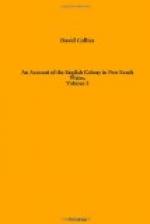Shortly after the publication of this order, several of the Irish prisoners having assembled at a private house, and making more noise than was proper during the night, were taken up, and lodged in the gaol until the morning; when they were liberated with assurances of being punished if brought there a second time.
Among other public and necessary works which were in hand at this time, must be noticed the construction of a new powder magazine. The former building had been placed at too great a distance from the principal battery, in a dangerous and insecure situation. The foundation of the new one was now dug in a more eligible spot, and where it could be much better secured; which had been rendered necessary from the turbulent disposition of the people lately arrived from Ireland.
March.] His Majesty’s ship the Reliance being completely worn out, and no longer capable of rendering any service to the settlement, it became necessary to give her such repairs as would enable her to reach England. In order, therefore, to ease the crown of such useless expense, she was fitted for sea, and sailed on the 3rd of this month on her homeward-bound voyage.*
[* The Reliance touched at the Cape of Good Hope and the Island of St. Helena, whence she brought some Indiamen safe home under her convoy. She arrived at Plymouth on the 26th of August, 1800. Nothing remarkable occurred during the voyage, except the discovery of an island, which, from its approach to the Antipodes of London, Captain Waterhouse named Penantipode island. He determined its latitude by one double altitude, and chronometer, to be 49 degrees 49 minutes 30 seconds S and its longitude, 179 degrees 20 minutes E. It was seen in the middle of the night; and as the nearest of the double altitudes by which its latitude was determined was nearly an hour past noon, hence, and from the change of place in the interval of four hours, the latitude ought not to be depended on nearer than from 5 minutes to 10 minutes. The error of the chronometer being uncertain at the time, no correction was applied to the longitude, which may very probably be within half a degree, or much nearer. When this island was seen, it was blowing a gale of wind. There were seals on it, and it did not appear quite so large as Norfolk Island.]
Captain Waterhouse, in an excursion which he made to the north arm of Broken Bay, wounded and secured a bird, of a species never seen before in New South Wales, at least by any of the colonists. It was a large eagle, which gave a proof of his strength, by driving his talons through a man’s foot, while lying in the bottom of the boat, with his legs tied together. it stood about three feet in height, and during the ten days that it lived was remarkable for refusing to be fed by any but one particular person. Among the natives it was an object of wonder and fear, as they could never be prevailed upon to go near it. They asserted, that it would carry off a middling-sized kangaroo. Captain Waterhouse hoped to have brought it to England; but it was one morning found to have divided the strands of a rope with which it was fastened, and escaped. A drawing had been made of it while in our hands, of which the annexed engraving is a copy.




